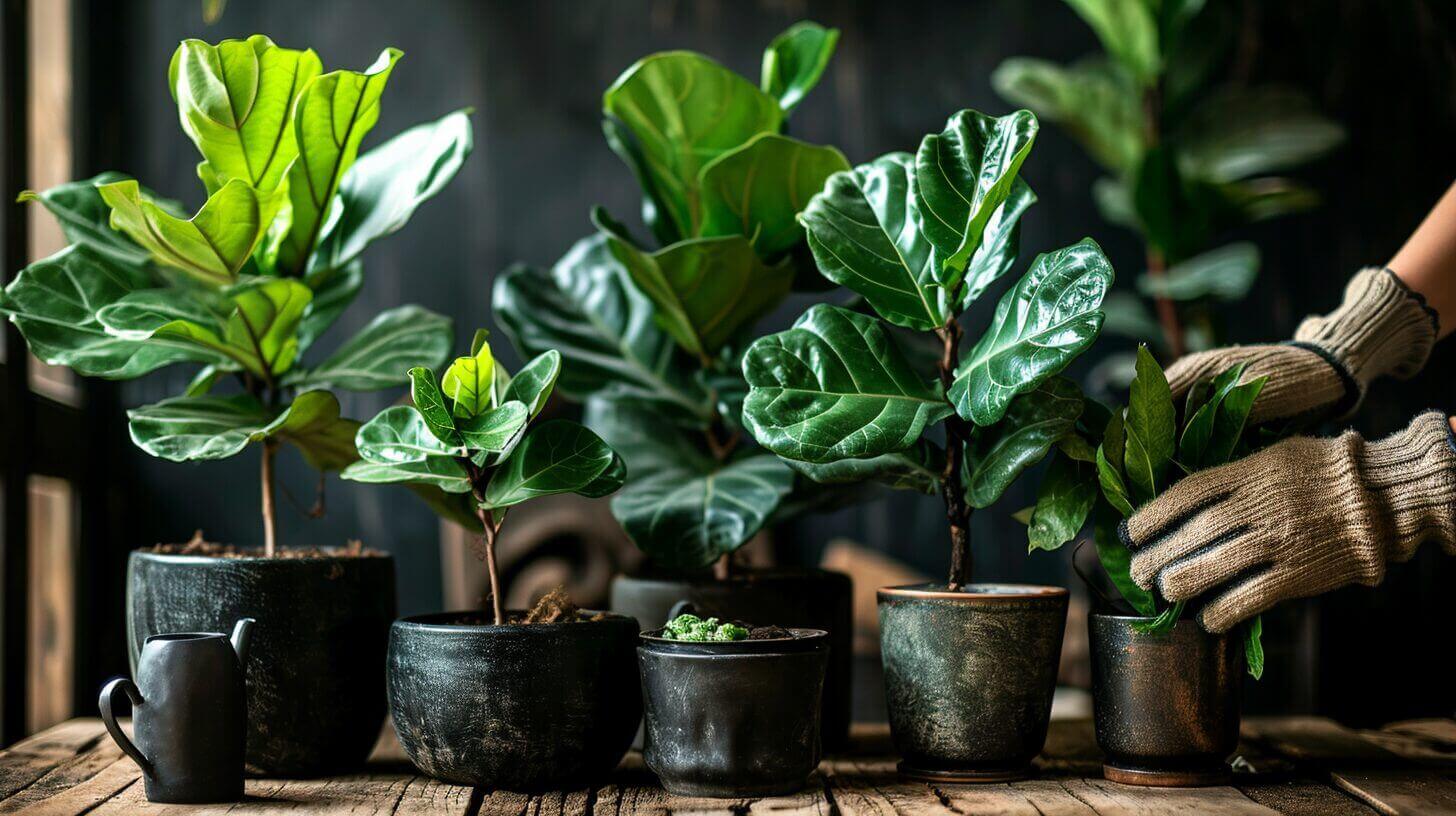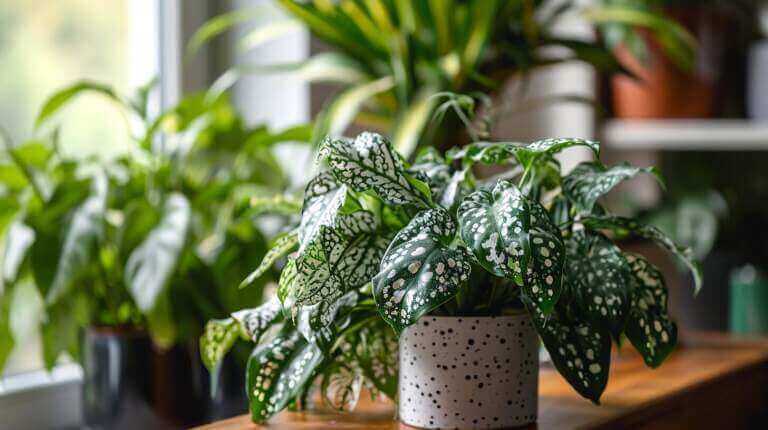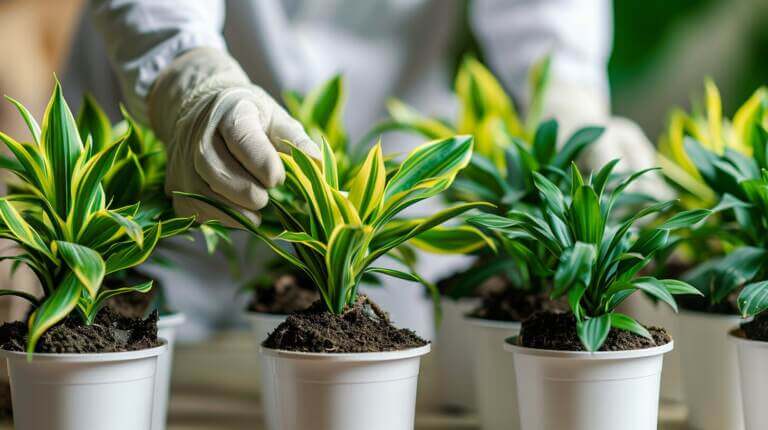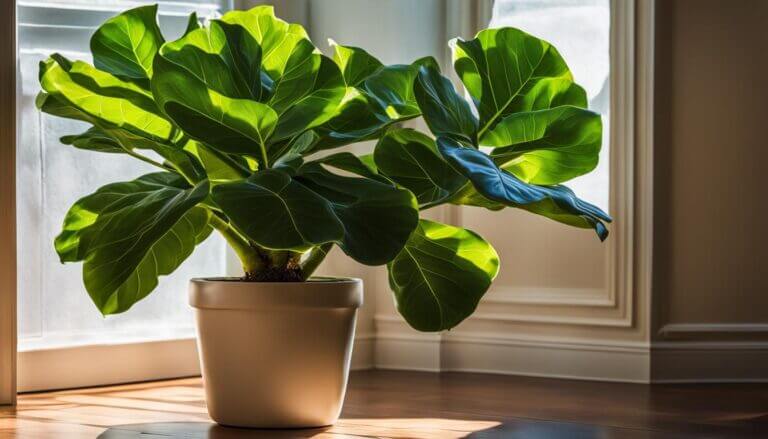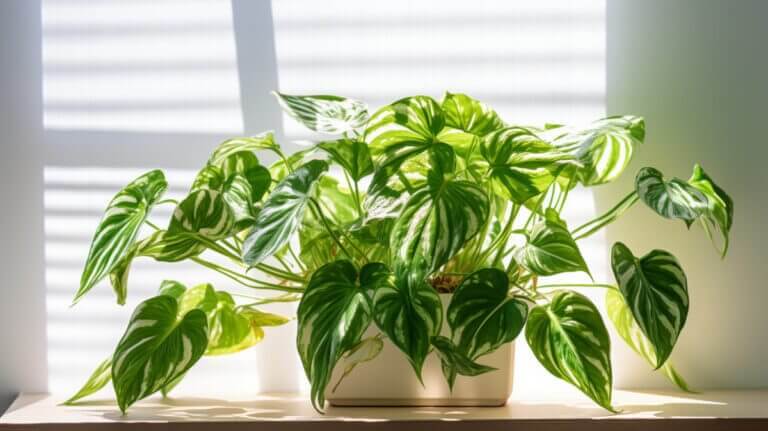How to Repot A Fiddle Leaf Fig Tree: Step By Step Guide
Growing a fiddle leaf fig is a rewarding experience, but as your plant continues to thrive, it may outgrow its current pot. Repotting your fiddle leaf fig is essential for its overall health and to prevent root rot. In this guide, I will walk you through the step-by-step process of repotting your fiddle leaf fig, ensuring that it continues to flourish in its new home.
Before we dive into the repotting process, let’s discuss the importance of choosing the right container size and using well-draining potting soil. These factors play a crucial role in maintaining the visual balance of your plant, promoting healthy root growth, and preventing water retention.
So, if you’re ready to give your fiddle leaf fig the care it deserves, let’s get started on repotting!
Key Takeaways:
- Repotting is necessary for proper fiddle leaf fig growth and to avoid root rot.
- Choosing the right container size ensures visual balance and provides enough room for the plant’s growth.
- Well-draining potting soil is key to preventing water retention and promoting healthy root growth.
- Proper drainage is crucial for the health and well-being of your fiddle leaf fig.
- The repotting process involves removing the plant from its current pot, loosening the roots, and placing it in a larger container with fresh soil.
Choosing the Right Container Size
When it comes to repotting your fiddle leaf fig, choosing the right container size is crucial for its health and growth. The size of the pot should be in proportion to the size of your plant, creating visual balance in your space. You want the pot to be approximately 1/3 the size of the plant, allowing enough room for root development and future growth.
Consider the current size of your fiddle leaf fig when selecting a planter. If your plant is still small, opt for a smaller-sized pot that can accommodate its growth. On the other hand, if your fiddle leaf fig is already large, you’ll need a bigger container to provide sufficient space for its roots to spread out.
Remember, choosing the right container size is not just about aesthetics but also about the overall well-being of your fiddle leaf fig. By selecting the appropriate planter, you can ensure that your plant has the room it needs to thrive and reach its full potential.
Table: Container Size Guide
| Fiddle Leaf Fig Size | Ideal Planter Size |
|---|---|
| Small (under 2 feet tall) | 6-8 inches in diameter |
| Medium (2-4 feet tall) | 10-12 inches in diameter |
| Large (over 4 feet tall) | 14-16 inches in diameter |
Use this guide as a starting point for selecting the right container size for your fiddle leaf fig. Remember, these are general recommendations, and you can adjust based on the specific needs and growth of your plant. By providing your fiddle leaf fig with a suitable container, you’ll create an environment that supports its growth and enhances the beauty of your space.
Using Well-Draining Potting Soil
When repotting your fiddle leaf fig, it’s important to use well-draining potting soil to promote healthy growth and prevent overwatering. The right soil mix will provide the necessary nutrients and oxygen for your plant’s roots to thrive.
A popular choice for fiddle leaf fig soil is a peat-based mixture combined with perlite. Peat-based soil offers good drainage while also retaining moisture, creating a balanced environment for your plant. Perlite, on the other hand, is a soil amendment that helps improve drainage by creating air pockets in the soil.
To create a well-draining potting mix for your fiddle leaf fig, combine two-thirds peat-based media with one-third perlite. This soil recipe will ensure that excess water can easily flow through the soil, preventing water retention and potential root rot.
Using the right potting soil is essential for the overall health and vitality of your fiddle leaf fig. It provides the foundation for successful growth, allowing your plant to thrive in its new pot. Remember to choose a soil mix that is specifically formulated for houseplants like the fiddle leaf fig to ensure optimal results.
Ensuring Proper Drainage
Proper drainage is essential for the health and well-being of your fiddle leaf fig. Without adequate drainage, the roots can become waterlogged, leading to root rot and other issues. It’s important to understand the factors that contribute to proper drainage and avoid common misconceptions.
Contrary to popular belief, placing gravel or rocks at the bottom of the pot does not improve drainage. In fact, it can actually raise the level of water saturation, causing potential harm to the roots. The perched water table, which is the height at which the soil becomes saturated, remains the same regardless of the container size or volume.
The key to ensuring proper drainage is to have a drainage hole in the pot. This allows excess water to escape and prevents waterlogged soil. When watering your fiddle leaf fig, water until it starts to drain out of the bottom of the pot. This ensures that any excess water is flushed out and helps maintain the right moisture level for your plant.
Remember, proper drainage is crucial for the health of your fiddle leaf fig. Be sure to choose a pot with a drainage hole and water your plant accordingly to keep the soil well-drained and your plant thriving.
Repotting Your Fiddle Leaf Fig
When it comes to repotting your fiddle leaf fig, the process can be quite simple. Start by gently removing the plant from its current pot, being careful not to damage the delicate roots. Loosening the roots slightly will help stimulate new growth and prevent them from becoming tightly bound.
Next, choose a larger container that provides ample room for the roots to spread out. Fill the new pot with a well-draining potting soil, such as a peat-based mix with perlite. This will ensure proper drainage and prevent water retention, which can lead to root rot.
After placing your fiddle leaf fig in the new pot, gently fill in the surrounding space with more soil, making sure to support the plant as you go. Once the pot is filled, give the plant a thorough watering to help settle the soil and encourage healthy growth.
The frequency of repotting your fiddle leaf fig will depend on its growth rate and the level of root overcrowding. As a general guideline, it’s recommended to repot every 12-18 months or when the roots have become tightly packed. By giving your fiddle leaf fig the right pot and soil, you’re setting it up for success and ensuring a thriving plant for years to come.
FAQ
When is the best time to repot my fiddle leaf fig?
It’s best to repot your fiddle leaf fig in the spring or early summer when the plant is actively growing.
How do I know if my fiddle leaf fig needs repotting?
If the roots are growing through the drainage holes or if the plant is top-heavy and tipping over, it’s time to repot your fiddle leaf fig.
What soil mix should I use to repot my fiddle leaf fig?
Use a well-draining mix such as a combination of peat moss, pine bark, and perlite to ensure good aeration for the roots.
What size of pot should I choose for my repotted fiddle leaf fig?
Choose a pot that is 2-4 inches larger in diameter than the current pot to allow room for the roots to grow.
How do I repot my fiddle leaf fig plant?
Gently remove the plant from its current pot, loosen the root ball, place it in the new pot with fresh soil, and water thoroughly.
What are the benefits of repotting a fiddle leaf fig?
Repotting allows for fresh nutrients and soil, prevents root rot, and gives the plant more space to grow, promoting overall health and vitality.
How often does a fiddle leaf fig plant need to be repotted?
Fiddle leaf figs like to be slightly root-bound, so plan to repot every 2-3 years, or when you see the signs of root congestion.
How should I water my fiddle leaf fig after repotting?
After repotting, water the plant thoroughly to help the new soil settle and ensure the roots are adequately hydrated.
How do I choose the right pot and soil for my fiddle leaf fig?
Select a pot with drainage holes and use a well-draining soil mix to ensure proper moisture levels and prevent waterlogging, promoting a healthy root system.
Source Links

